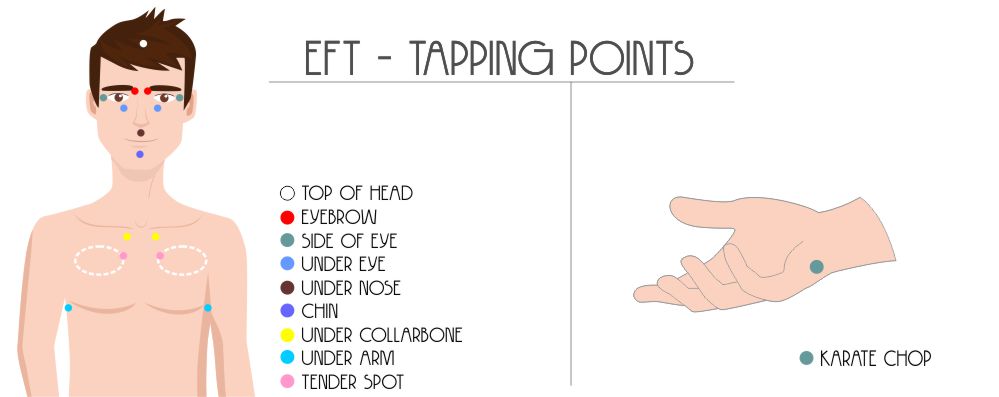The Budwig Center offers a range of alternative, complementary and integrative therapies to clients. One of these is known as ‘Emotional Freedom Techniques’ (EFT)[i], a holistic approach focusing on the link between psychological and physiological wellbeing. EFT (also known as tapping) is used for a range of symptoms and conditions, and can be used independently or with a trained practitioner. Our specialists at the Budwig Center provide EFT sessions, and also aim to enable the individual to use this technique independently.
EFT is positive, proactive, safe, non-invasive and drug-free. It can be effective even where traditional approaches fail and are cost-effective. There is no specialist equipment, and individuals can learn to use EFT independently.
What is EFT?
Emotional Freedom Technique is a relatively new type of treatment that includes aspects of cognitive behavioral therapy, desensitization and distraction techniques[ii]. EFT combines these with acupressure, and traditional therapies relating to the idea of a body’s energy flow. EFT practitioners identify pressure points, many of which relate to those parts of the body long held to be important by traditional medicine. The physical part of the technique is simply to use a repeated tapping motion to engage these points in turn. At the same time, the practitioner and the receiver of EFT identify issues such as anxiety, pain, or specific concerns, and voice them in a positive, affirming manner. EFT practitioners encourage their clients to approach the issues in an open, honest manner and believe that the technique relies on a positive approach to dealing with issues head-on.
The points identified by the developers of EFT are in keeping with traditional medical ideas of a body’s energy. These are the same ideas behind acupuncture and acupressure, both of which have had good uptake even in conventional medicine. The body’s innate energy flow, the focused lines described in so many forms of traditional medicine, are all considered essential to good health.
What Can EFT Be Used To Treat?
EFT has an excellent track record of treating depression and anxiety, cravings and phobias, chronic pain, insomnia and more. EFT also has physiological effects, and some of the physical and biochemical markers that it impacts are known indicators for other diseases. EFT, while effectively treating, for example, anxiety, has an incidental effect on important biomarkers for disease, reducing heart rate variation, resting heart rate and blood pressure, and modulating appropriate immunoglobulin and cortisol response[iii].
One of the conditions most effectively treated using EFT is post-traumatic stress disorder (PTSD) in veterans. This is significant because it can be incredibly hard to treat, and because EFT requires an honest vocalization of the client’s issues – it is hard to think of a more emotive and difficult subject, and the success of EFT in this field could be revolutionary.
What’s The Evidence For EFT?
As a fairly new therapy, EFT has rightly been the subject of some scrutiny and ongoing research. The best available evidence shows that EFT has a statistically significant positive effect on mental health and that the biomarkers associated with stress, depression, and anxiety are also significantly improved.
Studies involving people with severe stress and anxiety disorders found that those who received EFT had an important reduction in their cortisol levels[iv]. Cortisol is an important hormone that helps to regulate various body processes, but in the long-term, elevated cortisol levels are associated with impaired immune function, cardiovascular disease and accelerated aging[v].
What about NLP (Neuro-Linguistic Programming)?
Neuro-Linguistic Programming, as the name suggests, works on the principle that the words we use can program or change the perceptions we have. So by choosing optimistic affirmations and repeating them, we can have a positive effect on our minds and hearts, motivating ourselves and healing the pain from lack of self-love and regret. (for example).
We know that the way we “speak to ourselves” in our minds, quietly can have a detrimental impact on our lives. So, declaring healing affirmations out loud, with guidance from a professional, this can help us choose healthier thoughts that will affect every aspect of our lives and our wellbeing.
Emotional Healing At The Budwig Center
For a non-invasive, drug-free treatment to have such strong evidence showing that it actually changes some of the body chemicals known to cause disease is – to say the least – exciting. The potential implications on the field of medicine as a whole are huge, and we’re right at the start of it.
The Budwig Center is run by experienced practitioners who practice EFT alongside other treatments. For more information on the emotional trwatments, we offer, we encourage you to read our article Emotional Healing At The Budwig Center.
To find out more about the Budwig protocol, download the budwig guide.
————————
[ii] Waite, W.L. and Holder, M.D., 2003. Assessment of the emotional freedom technique. The Scientific Review of Mental Health Practice, 2(1), pp.1-10.
[iii] Bach, D., Groesbeck, G., Stapleton, P., Sims, R., Blickheuser, K. and Church, D., 2019. Clinical EFT (Emotional Freedom Techniques) improves multiple physiological markers of health. Journal of evidence-based integrative medicine, 24, p.2515690X18823691.
[iv] Church, D., Yount, G. and Brooks, A.J., 2012. The effect of emotional freedom techniques on stress biochemistry: a randomized controlled trial. The Journal of nervous and mental disease, 200(10), pp.891-896.
[v] Gold PW (2005) The neurobiology of stress and its relevance to psychotherapy. Clin Neurosci Res. 4:315Y324.

Me interesa mas informacion sobre este metodo, soy terapeuta por favor digame de sus cursos o libros.gracias
Martha,
Por favor, pongase en contacto con el Dr. Jenkins directamente a traves del sitio web en https://budwigcenter.com/contact-us/ con cualquier pregunta que usted tenga.
Gracias
Rob
Blog Admin